Olympus STF-8 Macro Twin Flash Review
Last year, Olympus Singapore loaned me a pre-launch unit of their new STF-8 Macro Twin Flash, together with their OMD-EM1 Mk1 and M.Zuiko Digital ED 60mm f/2.8 Macro for a test-run in the field. I’ve had the set for about a week — it was easy to use and the results were pretty good, although it took some time for me to get used to focusing using the LCD. This review is grossly overdue, but I’m posting it because I had been receiving questions on macro photography performance on micro four-third systems. This not a technical review. Instead, I will explain its pros and cons, as well as simple steps to maximise its capabilities.
Purpose of Twin Flash
Most major camera brands produce twin-flash systems for macro photography, but many macro photographers are still able to get great results with just a single flash. So… what’s the use of a twin flash then? Here are some of the minute differences.
-
Softer shadows (with proper diffusion)
Even with elaborate diffusion, single flash systems would have difficulty filling the shadows underneath the subjects — especially those with broad bodies. In twin flashes, the light usually approaches the subject from the side, which leads to much softer shadows.
-
Distributed lighting
With the light source from 2 different spots, the light is naturally more distributed, as opposed to having it from a single spot.
-
Flexiblity for creative lighting
Most twin flash systems allow the individual flashes to be detached, so that they can be placed at odd angles or even behind the subject. A great convenience!
Macro Twin Flash Systems Compared
I have used most of the macro twin flash systems in the field before, so here’s a quick overview of the differences that a macro photographer should know of.
| Olympus STF-8 | Nikon SB-R200 | Canon MT24-EX | Kuangren KX-800 | |
|---|---|---|---|---|
| Connection | Cable | Wireless | Cable | Flexible Arms |
| Battery | 4xAA | 1xCR123 per flash | 4xAA | 4xAA |
| Flash Mount | Cold Shoe | Custom | Cold Shoe | Fixed to Arms |
| Controller Mount | Hot Shoe | n/a | Hot Shoe | Hot Shoe |
| Weight (excl. batteries) | 283g | Flash 120g each | 404g | 450g (est.) |
| Guide Number | 27.9′ | 33′ each | 72′ | 190′ |
| Controls | Dual Dials | Camera/SU800 | Buttons/LCD | Dual Dials |
| Price (at time of post) | US$479 | US$170 each | US$829 | US$255 |
Note that for Nikon SB-R200, they can only be triggered wirelessly by the onboard flash of some Nikon camera bodies, or with the Nikon SU-800. Specifications above are for each flash unit excluding any mounts or arms, and more than 2 units can be used together.
It is also worth noting that Yongnuo has recently launched a Canon MT-24EX knock-off — the Yongnuo YN-24EX. Looks identical but at just 20% of the original’s price! Several users had reported a higher failure rate of this flash, but it is still worth checking it out.
Last but not least, Venus Optics is having a promotion this month (June 2017) for their lenses and the Kuangren KX-800. Check out the promotion details here.
Biggest Problem with Most Macro Twin Flash Systems
Most of the above twin-flash systems come with a custom ring attached to the front of the lens to mount the flashes. They are really convenient, but the problem arises when the flashes are mounted too close to the subjects, with little space in between to insert any effective light diffusion. This means that the ring that comes with Nikon’s R1 or R1C1 should never be used since they use custom mounts. The rings for Canon and Olympus have cold-shoe mounts, so that allows us to extend the height of the flash and distance it further away from the subject for better light diffusion.
To work around this issue, many macro photographers use flexible arms to mount the flashes. There are several options available, but that’ll be another topic altogether. Check out my macro equipment page for details on what I’m using.
For the photos in this post using the Olympus STF-8, I have installed tiny flash ballheads at the base of each flash so that they are at least 2 inches further away from the diffuser. It results in really soft and pleasing highlights on the subject.

Simple concave diffuser to encapsulate the subject evenly
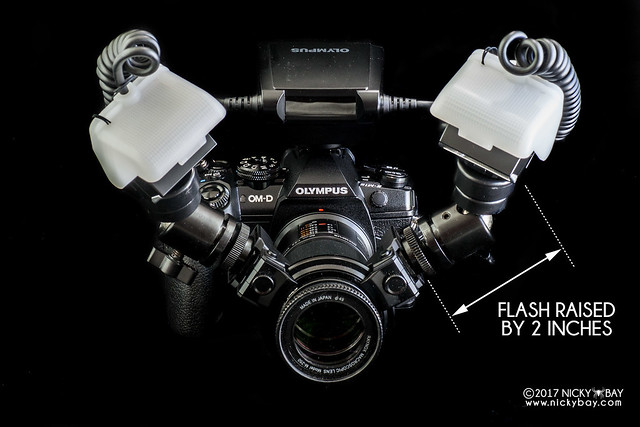
Mini flash ballheads raise the flashes for better, distributed lighting
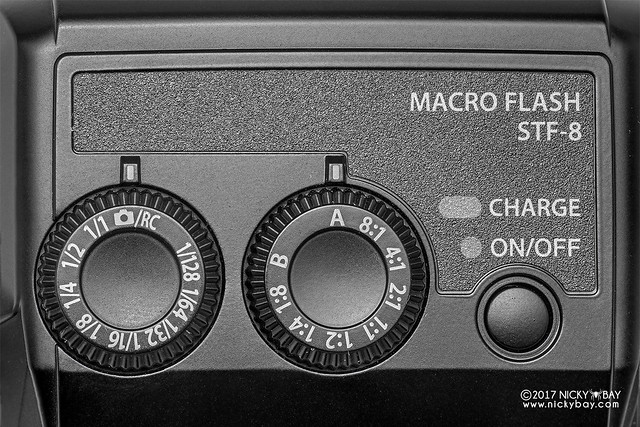
Dial controls allows the power ratio of each flash to be set quickly without running through complex menus. Unfortunately they are not illuminated so it might be tough to change settings in the darkness.
Note: The photos above show the latest OMD-EM1 Mk2, but the sample photos below were taken with the OMD-EM1 Mk1. The default diffuser caps were not used.
Field Trip Sample Photos
As I had the system for just a week, I made 2 short hikes to Durian Loop and Zhenghua Park in Singapore to try the system out. I have a lot more photos, but these stood out and showcases the benefits of a twin-flash system. All photographs in this series were taken with the OMD-EM1 Mk1 with M.Zuiko Digital ED 60mm f/2.8 Macro and Raynox DCR-250, lighted with the STF-8 Macro Twin Flash and diffused with a DIY diffuser.
Huntsman spider (Sparassidae)
I photographed many huntsman spiders with this system. The lighting was obviously soft, thanks to Victor’s diffuser. =D Also, the dual highlights appeared softer because they were elevated with the mini ballheads away from the diffuser.
Huntsman spider (Sparassidae)
Consistently smooth lighting can be seen in the reflection on the eyes. Even the areas under the legs were lighted up sufficiently.
Huntsman spider (Heteropoda sp.)
Did I mention that I photographed a lot of huntsman spiders?
Huntsman spider (Pandercetes sp.)
Very common huntsman found on tree trunks. The white hairs would’ve been over-exposed in most poorly diffused systems.
Wrap-round orb weaver (Talthybia sp.)
Even in orb weavers, there was no loss of detail in the hairs. This is largely contributed by good light diffusion, and partly by the camera sensor.
Daddy-long-legs spider (Pholcidae)
These little daddy-long-legs spiders have just hatched, and would have been perfect for back-lighting, but I wasn’t too accustomed to this system yet.
Darkling beetle (Tenebrionidae)
Highly reflective beetles like this would be great for testing out your light diffusion. I ensured that the entire subject was covered by the diffuser to eliminate the dark areas on its body.
Jumping spider (Salticidae)
The reflection on the eyes of jumping spiders are perfect for checking the light distribution on the diffuser. Faint highlights can be observed in the eyes.
Fungus weevil (Tropiderini)
Shadows were almost completely eliminated in this fungus weevil shot due to the light from both sides.
Lynx spider (Oxyopes sp.)
The colours on this male lynx spider were also brilliantly reproduced with the even lighting.
Mantis (Creobroter sp.)
A curious mantis nymph caught grooming and arching its head. Again, minimal shadows spotted.
Bark scorpion (Lychas scutilas)
Close up on a bark scorpion. For close-ups of subjects on a flat surface like tree trunks, some single flash systems may have difficulty filling the shadows. A dual flash would help alleviate such a problem.
Jumping spider (Portia sp.)
We found a pair of Portia spiders on the same tree! It was difficult to expose this shot properly without over-exposing the “moustache” but it turned out ok.
Jumping spider (Portia sp.)
The male Portia was hanging out in a web. Not sure if the web belonged to another spider.
Copper-cheeked frog (Hylarana labialis)
Finally, a large eye to test my diffusion on! The shape of the diffuser can be seen in the highlights due to the larger eye.
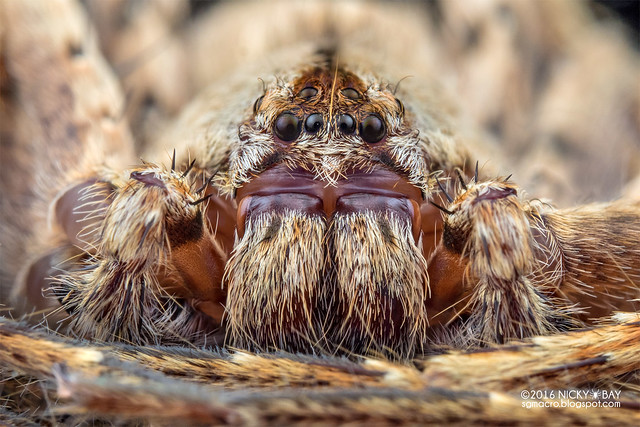

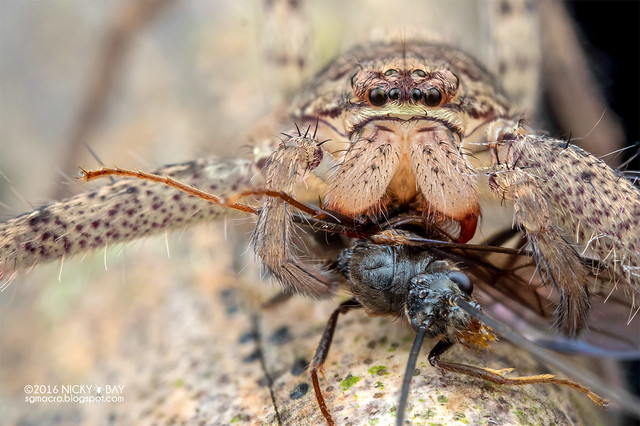
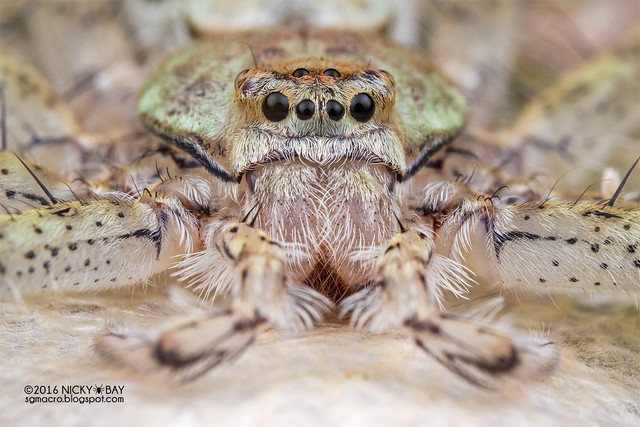



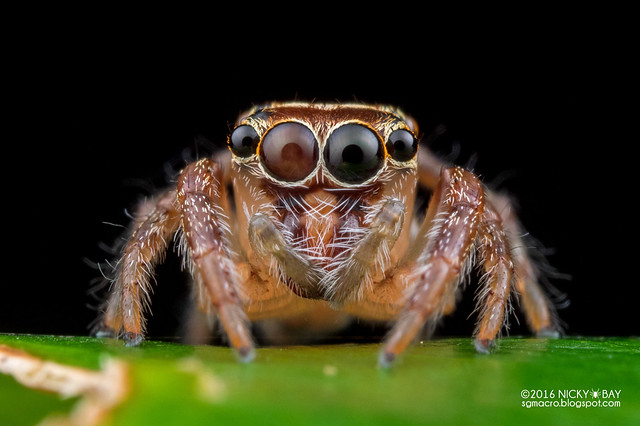
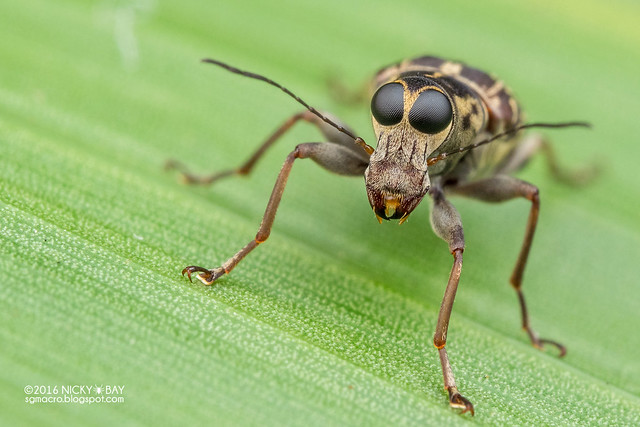
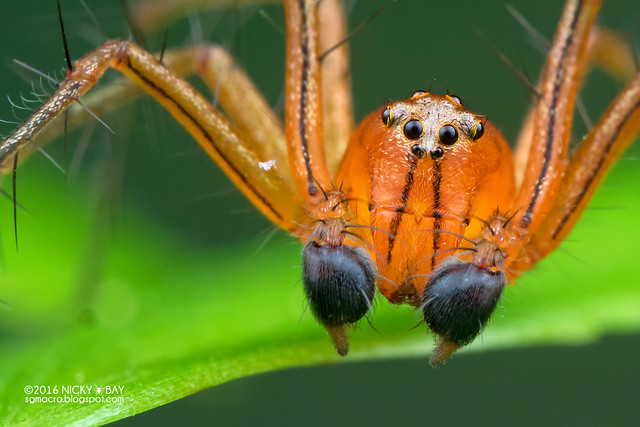
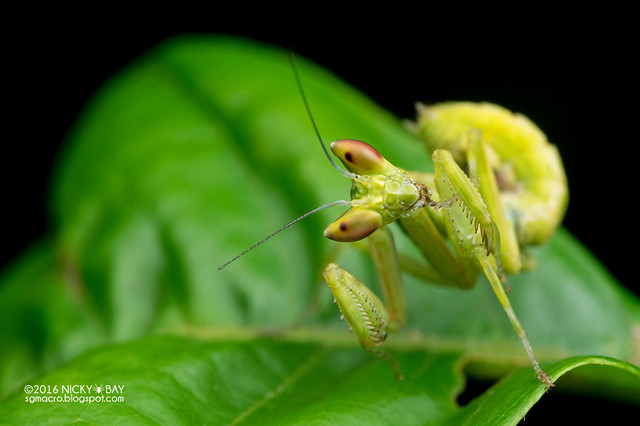
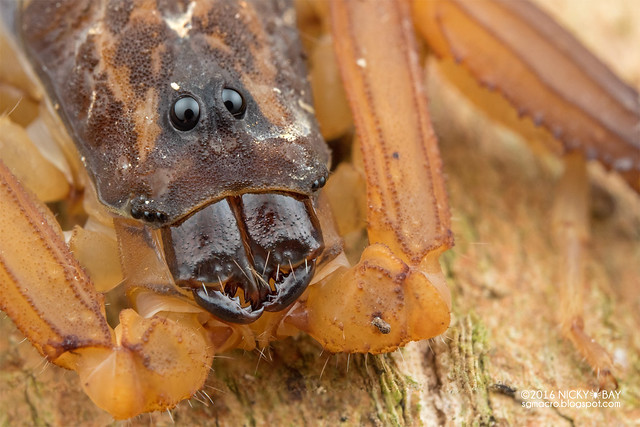
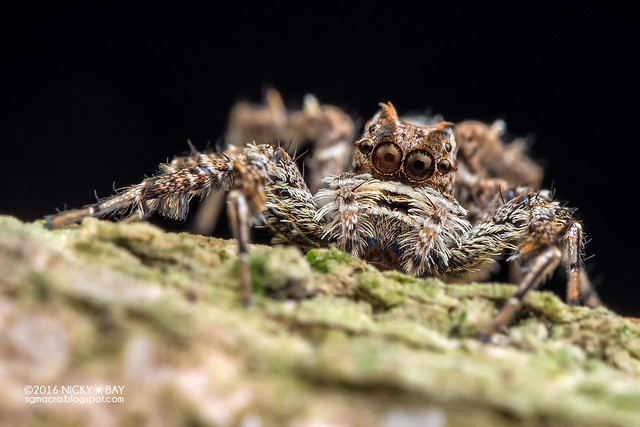

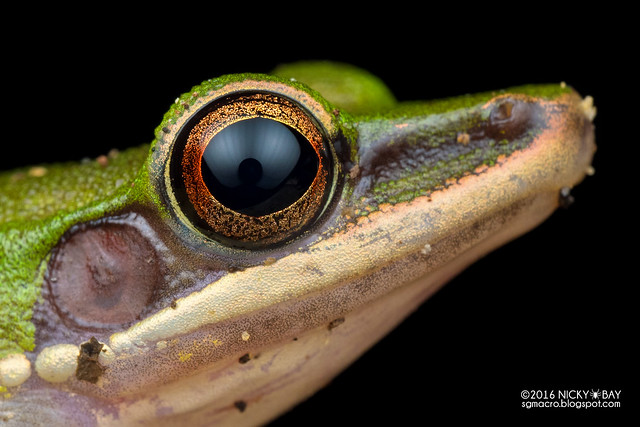
Olympus STF-8 Technical Specifications
These technical specifications were taken from Olympus.
| Type | Clip-on type TTL auto sync macro flash Olympus wireless remote control flash system compatible (Commander function only) |
|---|---|
| Guide Number | One flash: 6.0 (ISO 100•m), Two flashes: 8.5 (ISO 100•m) |
| Firing Angle | Vertical: approx. 61 degree, horizontal: approx.72 degree (flash head short side, long side/one flash, covers the angle of view of a 12mm (35mm equivalent: 24mm)) |
| Left-right Light Intensity Ratio | One head firing / Two heads firing (1:8 to 1:1 to 8:1) Can be set using dial on flash |
| Included Diffuser | Open/Close type |
| Flash Modes | TTL-AUTO, Manual |
| Remote Control (RC) | Flash mode: RC Channel: 4 Group: 4 groups, independently controlled (3 slaves, 1 camera flash)
|
| Flash Head Movement Angle | Up/down facing: front 0°, upward facing 0° – 60°, downward facing 0° – 40°
|
| Flash Time | 1/1000 sec. or less |
| Display LED | Charging display (orange), power display (green) |
| Power Supply Batteries / Recommended Batteries | AA alkaline batteries: 4, AA NiMH batteries: 4 |
| Low Power Function | Power automatically turns off after being left alone for approx. 10 min in sleep mode
|
| Flash Compensation | Can be set on the camera |
| Manual Flash | Full (1/1) to 1/128 (Can be set on flash / camera) |
| Charging Time | Approx. 4 sec. (when using AA alkaline batteries) Approx. 4 sec. (when using AA NiMH batteries) |
| Flash Emission Count | Approx. 480 times (when using AA alkaline batteries) Approx. 1330 times (when using AA NiMH batteries) |
| Operating Environment | -10 to 40°C |
| Splashproof Construction | Splashproof |
| Size | Controller: W 66.9 mm x H 59.1 mm x D 68.5 mm (excl. protrusions) Flash: W 45.4 mm x H 39.7 mm x D 42.3 mm (excl. protrusions) |
| Weight | 283 g (incl. Controller, flashes and cords, excl. Ring adapter, joints and batteries) |
| Box Contents | Flash case, Two diffusers, ring adapters (φ46mm, φ62mm), Two joints, instruction manual, Warranty Card |
Conclusion
The Olympus STF-8 Macro Twin Flash is the first macro twin-flash system for micro four-thirds (M4/3) systems, and looks like a mini Canon MT-24EX. Its key selling point is its compactness and light weight, which is in line with what we expect of M4/3 systems. It is also splash-proof to lessen your worry in wet conditions. I only wish that it had a higher guide number which would be helpful for larger subjects.
The default cap diffusers are definitely insufficient. A DIY concave diffuser needs to be built onto the tip of the lens, and the twin flashes need to be raised above its default mounts. With that, you can be confident of well diffused lighting in your macro photographs.
Thanks to Olympus for the loan set, and Victor Cheah for facilitating the loan!
If you like my macro photographs, consider joining the next macro photography workshop in Borneo Bootcamp 2017 and I’ll promise you an unforgettable adventure in the heart of Borneo with LOTS of bugs and spiders.
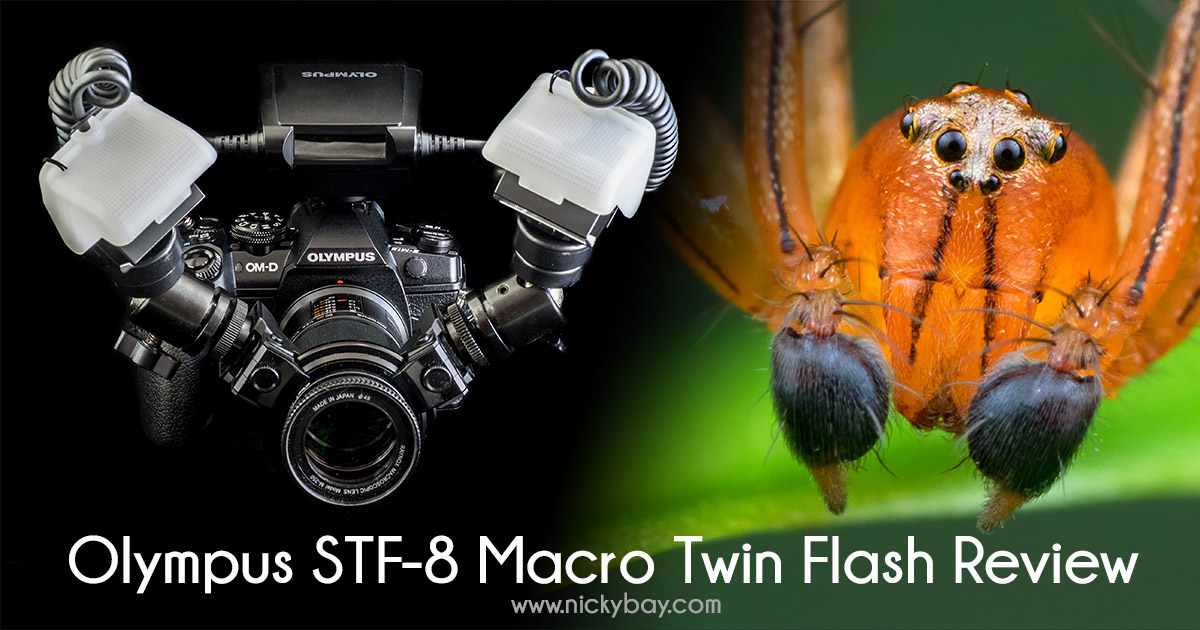


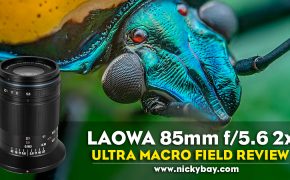
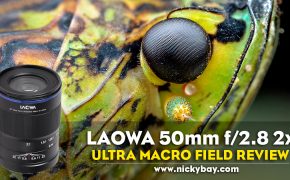
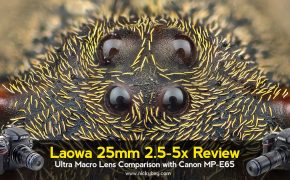
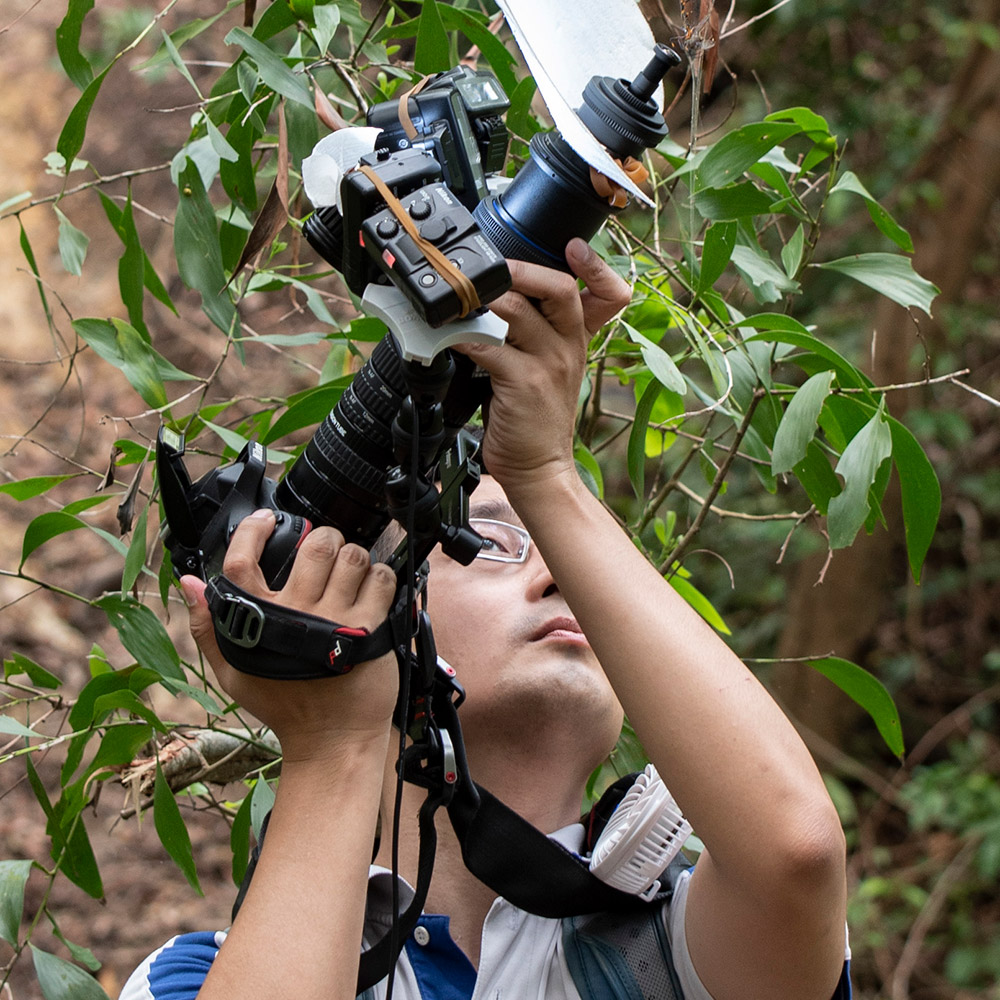










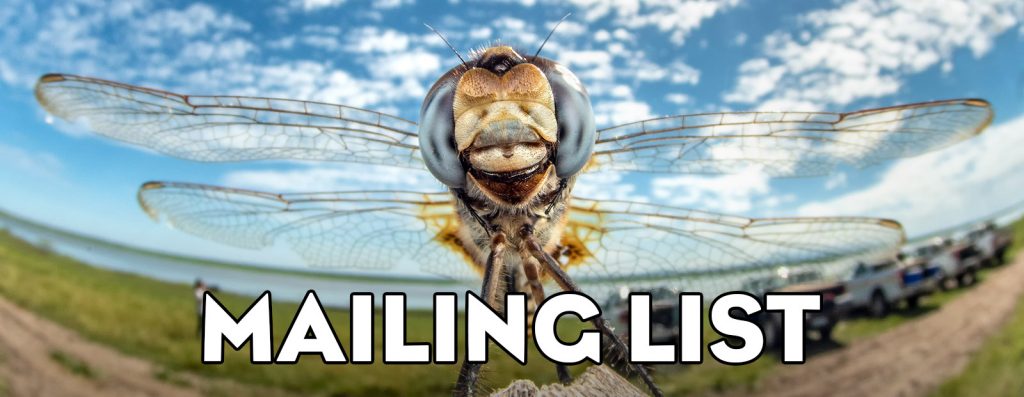
Vv Shanmuga Sundaram
Stunning photography, have seen your work and got to say its amazing.I first started off in macro photography, am into wildlife as well.But a well planned close- up is out of this world in my mind.I do macro work mostly in the dark, at ghostly hours in mandai.Thats when the forest is fully alive and reveal itself.
Equiptment D750 +100F2.8+ i40 flash with raynox 250, and self made diffuser. Got plenty to work on and improve.
Tom Watson
Hi Nicky
I just read your page about the Olympus STF-8 and found it really useful I just wish I has read it before buy it.
Can I ask where you got your concaved diffuser or did you make it?
Thanks Tom
Walter Meissner
You show a DIY conical diffuser for the Olympus STF-8 macro ring flash.
I have been looking where I can buy this, and come up empty handed.
Would you elaborate on the brand and type of this conical diffuser ?
Thanks
Nicky Bay
Hi. It is just a piece of white translucent plastic cut out from a flexible chopping board or folio from the dollar shop. No brand.